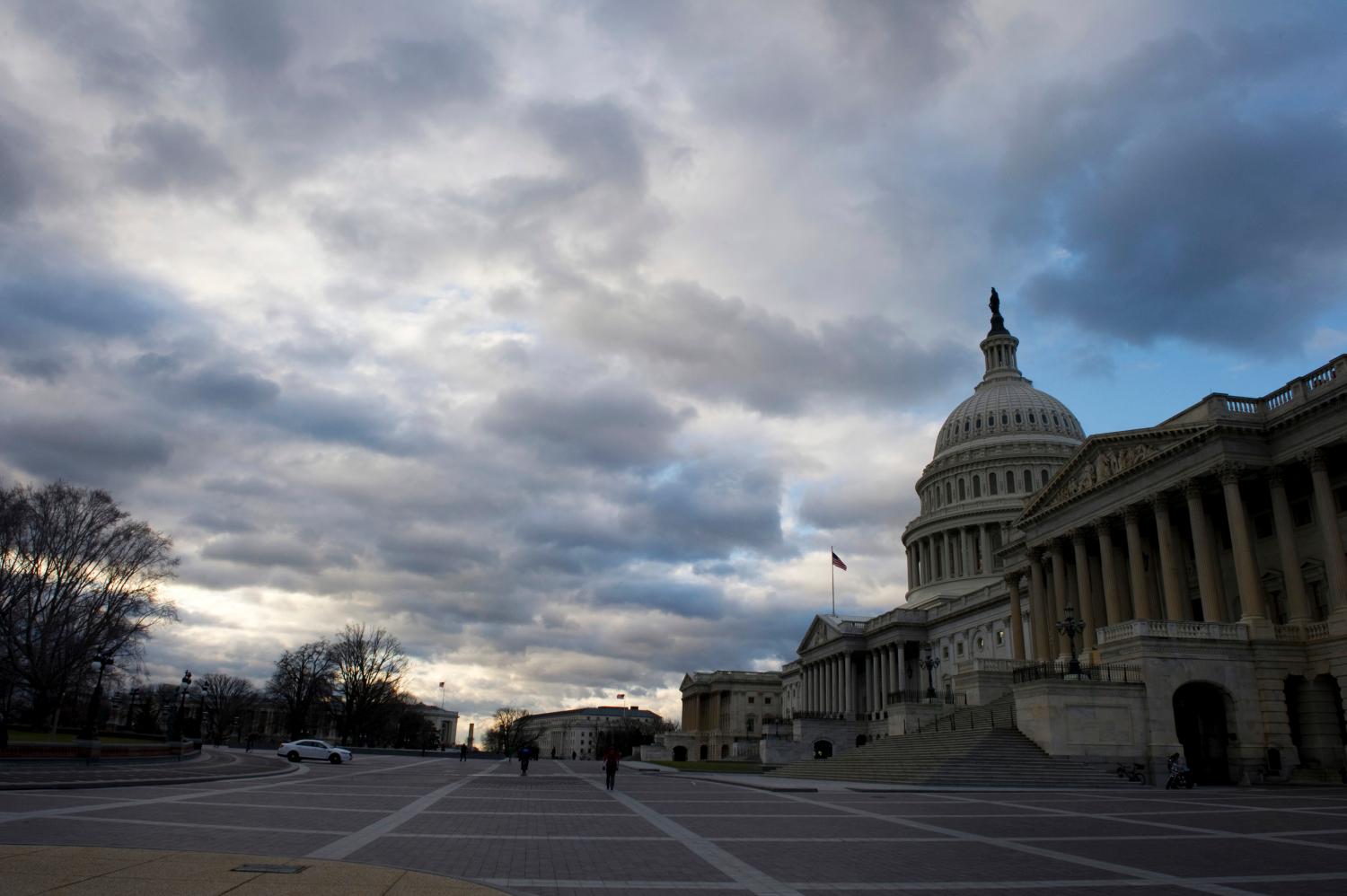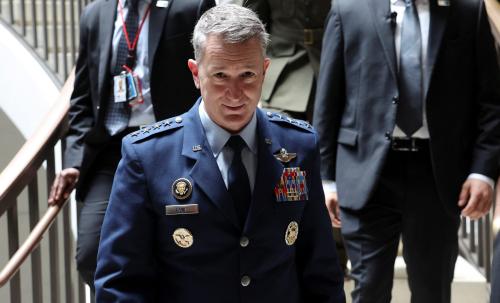In proposing a $48 billion defense budget increase for 2003 following a large increase in 2002, President George W. Bush has followed in the budgetary footsteps of former President Ronald Reagan and Reagan’s defense secretary, Caspar Weinberger. Adjusted for inflation, Bush’s 2003 defense budget would be $50 billion higher than the 2001 budget. By 2007, the real dollar defense budget would go up $30 billion more, approaching the peak levels of the Reagan years.
Even in these troubled times, such increases are too much. Further defense budget growth is needed. But the Pentagon needs to be more selective about its weapons modernization plans. In addition, after several successive years of increases, military pay is now in fairly good shape, as reflected in the recently improved statistics for recruiting and retaining personnel. America’s military men and women are of outstanding caliber and deserve proper compensation, but their pay is no longer poor compared with private sector employment, and the administration’s plans for large increases are excessive. The large research and development budgets proposed by the administration exceed the already hefty increases advocated by President Bush during his campaign; given that research and development was not severely cut during the 1990s, such growth seems unnecessary now. Finally, the Pentagon also needs to reform many of the ways it provides basic services such as military health care, military housing, and various base operations. Unfortunately, if budgets get too big, the Pentagon’s incentives to look for efficiencies are likely to weaken. On balance, the planned increases in defense spending are roughly twice as much as would be appropriate in the years ahead. Instead of the administration’s plan for a $396 billion defense budget in 2003, which would increase to $470 billion by 2007, next year’s budget should be about $370 billion and the 2007 level should not exceed $430 billion.
POLICY BRIEF #95
The Bush Administration’s Proposed Defense Budget
The Bush administration’s fiscal 2003 budget request for the Pentagon fleshes out the budgetary details of Secretary of Defense Donald Rumsfeld’s Quadrennial Defense Review (QDR), released last September 30. The QDR was a cautious document on the whole. While it unveiled several new initiatives, they were largely conceptual ones. The QDR increased the military’s emphasis on homeland security. Relative to the Clinton defense plan, it also adopted a somewhat less demanding type of two-war scenario as the proper standard for sizing American armed forces. In addition, it placed greater emphasis on missile defense, defense research and development, and joint-service training and experimentation.
But otherwise, the QDR essentially reaffirmed the Clinton administration’s weapons modernization agenda and force structure-retaining about 1.4 million active-duty troops, ten active-duty army divisions, three active-duty marine divisions, twelve aircraft carrier battle groups, about fifty attack submarines, and roughly twenty tactical fighter wings, as well as about 250,000 active personnel deployed or stationed abroad. After rampant early speculation that overseas troop deployments would be reduced, a generation of weapons programs would be skipped, and the size of the U.S. ground forces would be curtailed significantly, Rumsfeld’s defense plan proved far more cautious and far more consistent with that of his predecessors.
The September review was silent, however, on the question of costs. Now we have the bill for this defense plan, and that is where the big changes arise. The Clinton administration’s national security budget had grown to about $300 billion a year by 2001 (including about $15 billion in annual funding for nuclear weapons activities at the Department of Energy). Incorporating the effects of September 11 and Operation Enduring Freedom in Afghanistan, President Bush’s budgets are now as follows: $329 billion in 2001, $351 billion in 2002, and $396 billion proposed for next year. Breakdowns of the Pentagon’s part of these budgets are shown in table 1.
| Budget Category | 2002 Estimate | 2003 Estimate |
|---|---|---|
| Military Personnel | 82.0 | 94.3 |
| Operations and Maintenance | 127.7 | 150.4 |
| Procurement | 61.1 | 68.7 |
| RDT&E | 48.4 | 53.9 |
| Military Construction | 6.5 | 4.8 |
| Family Housing | 4.1 | 4.2 |
| Other | 4.5 | 3.0 |
| Total Discretionary Budget Authority (not including Department of Energy) | 334.3 | 379.3 |
< />Equally striking, however, are the price tags envisioned for the years ahead: $405 billion (2004), $426 billion (2005), $447 billion (2006), and $470 billion (2007). Congress will not act on those budget plans this year, but they show where the Bush administration’s budgets are headed if they are approved by Congress-toward a period of very high defense spending.
In a sense, the increases are not quite as great as they seem. The figures for 2001-2003 include the costs of the anti-terrorism war; all the figures include funding for the Department of Defense’s heightened vigilance and contributions to homeland security after September 11. These combined costs are now running about $30 billion a year. Moreover, due to the effects of inflation, the $470 billion budget for 2007 represents about $425 billion when expressed in 2002 dollars. And compared to the size of the U.S. economy, these budgets would still reflect a smaller fraction of Gross Domestic Product (GDP)-about 3.5 percent-than at any time during the cold war.
Still, despite these factors, the increases are remarkable. The Pentagon’s budget in 2007 would be a full $100 billion greater than what the Clinton administration had en-visioned for that year in its own long-term plan. And as noted, these figures would approach the peak levels of the Reagan years, as well as those of the Vietnam era (see figure 1, [below]).
Source: National Defense Budget Estimate for 2002 and Background Briefing on the Fiscal 2003 Department of Defense Budget Submission, Feb. 1, 2002. Note: 2003-2007 estimates are based on President Bush’s 2003 budget request.
Why does President Bush wish to restore defense spending to such high levels? He does not plan to increase the size of the military, which remains one-third smaller than in cold war times. Moreover, with the exception of missile defense, Bush administration officials have not yet added any major weapons systems to the modernization plan they inherited from their predecessors. Instead, the Bush administration claims that in general it is only fully funding the force structure and weapons procurement agenda that was laid out in Secretary of Defense William Cohen’s 1997 Quadrennial Defense Review, as well as the immediate exigencies of the war on terrorism. This argument can be seen explicitly in the Pentagon’s breakdown of the proposed increase in the 2003 defense budget (see table 2).
The main point that the Bush administration wishes to make with this table is that most of the $48 billion added between 2002 and 2003 is effectively beyond the control of a scrupulous bookkeeper, given the obligations inherited from the Clinton administration and the Congress as well as the demands of war. The Bush administration is essentially arguing that $36.6 billion of the increase is automatic, and another $10 billion is simply a conservative estimate of what next year’s military operations will entail. Indeed, were it not for the $9.3 billion in program cuts, postponements, and accounting changes the Bush administration managed to make, virtually no money would be left for other purposes such as increased weapons acquisition. Even the $9.8 billion added for weapons will fund a plan for fighter jets, ships, Army transformation, and other advanced systems that was primarily inherited from the Clinton administration.
| Enacted Budget for 2002 | 331.2 |
| Upward Adjustment for Inflation | 6.7 |
| “Must Pay” Bills | |
| Over-65 health care | 8.1 |
| Civilian retirement/health care | 3.3 |
| Military and civilian pay raises | 2.7 |
| (Subtotal) | (14.1) |
| Realistic Costing | |
| Realistic Weapons Costing | 3.7 |
| Readiness Funding | 3.1 |
| Depot Maintenance | 0.6 |
| (Subtotal) | (7.4) |
| Cost of War (including $10 billion contingency fund) | 19.4 |
| All Other Requirements (e.g., Weapons Acquisition) | 9.8 |
| Savings from Transfers and Program Cuts, Delays | -9.3 |
| Total 2003 Budget Request | 379.3 |
|---|
For those who doubt the need for added defense spending, it is further true that a military of a given size costs more to maintain each year. Whether it is the price of weaponry, the burden of providing military health care to active-duty troops and their families as well as to retirees, or the price of paying good people enough to retain them, most defense costs rise faster than inflation. Moreover, the U.S. military took a “procurement holiday” of sorts during the 1990s, since money was tight and since it had so much modern weaponry on hand after the Reagan buildup. That holiday must now end, as systems age and require refurbishing or replacing.
In addition, the lessons of Operation Enduring Freedom need to be built upon. That conflict has demonstrated, more than any other before, the importance of unmanned aerial vehicles, real-time battlefield information networks, certain precision munitions, and good equipment for special operations forces. These and most other “transformation” initiatives proposed by the Bush administration merit support. (see table 3).
Because of these various factors, real defense spending should indeed continue to increase, as it has been doing since 1999. It makes perfect sense that today’s military, though only two-thirds the size of the cold war force, might cost nearly as much. What is surprising, however, is that the Bush budget would not only reach but easily exceed the cold war defense budget average.
An Alternative to the Bush Strategy and Budget
It is true that the 1997 QDR, developed during a period of fiscal restraint, did not provide enough funds for its own proposed plan. But Congress and the Clinton administration later added more than $20 billion to the annual real dollar budget, and Secretary Rumsfeld added another $20 billion for 2002 without counting added costs due to September 11. So the yearly baseline has already grown by $40 billion even as the plan for forces and weapons has remained mostly unchanged. Secretary Rumsfeld and President Bush now tell us that is still not enough. Alleging a decade of neglect, they claim that further spending increases are needed for military pay, readiness, infrastructure, health care, research and development, and weapons procurement. Overall, the Bush administration proposes to add a total of more than $400 billion from 2002 to 2007. It is true that each of these main accounts still needs more funding. But the needs are not sufficient to require such large increases.
Before examining each major defense account individually, there is the matter of war costs to address. The Bush administration has requested almost $20 billion for such costs in the 2003 budget-$10 billion as its best guess of the cost of military operations that year, and $9.4 billion primarily to replenish weaponry and spare parts inventories and otherwise recuperate from the effects of the war on terrorism to date. However, to ensure transparency and to protect Congress’s role in the budget process, most of the latter costs should be added to the 2002 supplemental appropriations bill, and most of the former costs should be appropriated next year, if necessary. Making them supplemental appropriations will also avoid artificially inflating the defense budget for 2003 in a way that would make defense increases in future years look smaller than they really are.
Pay
After the largesse of the last few years, military pay has never been higher in inflation adjusted dollars. Partly as a result, recruiting and retention have improved markedly in recent years.
Most additional increases should be targeted at those few technical specialties where the Pentagon still has trouble attracting and keeping people, rather than the entire force. In that regard, the Bush administration’s plan to add a total of $82 billion to military pay over the 2002-2007 period is excessive. Since troops are receiving improved housing and health benefits at present, further pay raises should be held to no more than the rate of inflation. Over the 2003-2007 period, this approach would save about $30 billion relative to the Bush administration’s plan (individuals would still get additional raises as they were promoted, of course).
In addition, another $5 billion could be saved through 2007 by modestly reducing the number of individuals in the military. Generally speaking, this should not be done by cutting the number of major combat units below current levels, but rather by making some of them slightly smaller in recognition of the enhanced capabilities of modern weaponry-as well as the need for a lighter and more deployable force.
| Convert 4 ballistic-missile submarines to cruise missiles | 1,018 |
| Add funding for new satellite communication system | 826 |
| Add funding for space-based radar | 43 |
| Add funding for Global Hawk unmanned aerial vehicles (UAVs) | 629 |
| Accelerate development of new UAVs | 141 |
| Upgrade, arm, and purchase more Predator UAVs | 158 |
| Develop small-diameter bomb | 54 |
| Initiate Navy unmanned underwater vehicle | 83 |
| Start new program for advanced surface combatant technologies | 961 |
| Expand wideband, secure global communications network | 1,300 |
| Upgrade data links to combat platforms, troops | 3,300 |
Operations and Maintenance
This part of the budget funds a wide array of defense activities related to so-called military readiness, including training, equipment repair, fuel, and other necessities for overseas deployments, and most spare parts purchases. It also funds the salaries and health care of civilian employees of the Department of Defense. Even though readiness funding per troop is by far at its highest real dollar level ever, the Bush administration proposes adding $146 billion to this budget over the 2002-2007 period.
But reform in military health care could save $15 billion over that period, if ideas proposed in the past by the Congressional Budget Office (CBO)-including merging the independent health institutions of each military service, employing market-based care wherever possible, and considering introduction of a small co-pay for military personnel-were adopted. At a time when Congress has legislated a huge increase in the defense health budget by mandating free lifetime care for retirees, reform is all the more important.
In addition, giving incentives to local base commanders to find efficiencies in their operations might help limit real cost growth to 2 percent rather than 2.5 to 3 percent a year in other parts of the budget, saving $10 billion more.
Research and Development
President Bush has rightly emphasized research and development ever since he began running for president, but again, the 2002 budget already added large sums to this area. Current real spending on research, development, testing, and evaluation already exceeds the levels of his father’s administration and roughly equals those of the peak Reagan years. No more than another $1 billion is needed for the 2003 budget and beyond. For example, economies should be possible by canceling one or two major weapons, slowing the army’s future combat system until underlying technologies are more promising, and slowing at least one or two missile defense programs out of the eight now under way (while modestly increasing research and development on a national cruise missile defense). Rather than add $99 billion to the pre-existing plan, about $55 billion should suffice for 2002-2007 (reflecting primarily the increases in the 2002 budget that would be sustained thereafter).
Procurement
The Clinton administration spent an average of about $50 billion per year to buy equipment; the figure is now about $60 billion. According to CBO, however, the expensive modernization plans of the military services might imply an annual funding requirement of $90 billion or more. Accordingly, the Bush/Rumsfeld budget envisions procurement funding of $99 billion in 2007.
But Operation Enduring Freedom has underscored the potential of relatively low-cost systems, such as Global Positioning System (GPS) guidance kits added to “dumb bombs,” unmanned aerial vehicles (which cost a fraction of what manned fighters do), and real-time communications networks among sensors and weapons platforms.
To be sure, expensive weapons such as aircraft carriers have been used as well. Moreover, not every future foe will be as militarily unsophisticated as the Taliban and al Qaeda. That said, the services need to prioritize. They should recognize, as former Vice Chairman of the Joint Chiefs of Staff Bill Owens has argued, that the electronics and computer revolutions often promise major advances in military capability without inordinate expenditures of money.
The current procurement budget of about $60 billion does need to rise to the $70 billion level proposed for 2003; in fact, it probably needs to reach $75 billion or higher. But the $99 billion level envisioned for 2007 is greatly excessive.
For many critics, the problem with Rumsfeld and Bush’s weapons plan is that it protects the traditional priorities of the military services without seeking a radical transformation of the U.S. armed forces. But this basic criticism is not quite right. Individual programs or omissions in the Bush plan can be debated, but it is beyond serious doubt that the Bush administration has an aggressive program for so-called defense transformation (see table 3). As is appropriate for such an effort, most of the emphasis is in the realms of research, development, and experimentation, where the administration envisions spending $99 billion more than the Clinton administration would have by 2007 (even though, as noted, these areas of the defense budget were not severely cut in the 1990s). The problem is a more classic one of unwillingness to set priorities. Despite the absence of a superpower challenger, the administration proposes replacing most major combat systems of the U.S. military with systems costing twice as much-and doing so throughout the force structure.
A more prudent modernization agenda would begin by canceling at least one or two major weapons, such as the Army’s Crusader artillery system. In addition, rather than replace most major weapons platforms with systems often costing twice as much, the Pentagon would only equip a modest fraction of the force with the most sophisticated and expensive weaponry. That high-end or “silver bullet” force, as CBO has described it, would be a hedge against possible developments such as a rapidly modernizing Chinese military. Otherwise, the rest of the force would be equipped primarily with relatively inexpensive upgrades of existing weaponry carrying better sensors, munitions, computers, and communications systems. For example, rather than purchase some 3,000 joint strike fighters, the military would buy about 1,000, and otherwise purchase planes such as new F-16 Block 60 aircraft (and perhaps even some unmanned combat aerial vehicles in a few years) to fill out its force structure.
Conclusion
In times of war, it is often militarily necessary, and politically natural, for defense spending to rise. But the nation is presently running the risk of spending too much on defense. Many members of Congress are fearful of challenging a popular president in a time of war over his proposed defense requests.
This dynamic puts the nation’s fiscal health and domestic agenda at risk and may not even be good for national security. Defense budgets may decline in the years ahead, especially as the nation moves farther away from September 11. If that happens, the Bush administration may then regret that it sacrificed its opportunity to promote the kind of defense reform it championed on the campaign trail and during its first few months in office. The country could be left with a defense program that is too large and expensive for the resources at hand.
Some defense spending increases, beyond those already put in place since 1999, are needed. But most of those proposed by the Bush administration have only limited relevance to the war on terrorism. They should not be justified on the grounds of fighting al Qaeda, other terrorist organizations, or state sponsors of terrorism. And many are not needed on other grounds, either. The $48 billion increase requested for 2003 should be cut to about $20 billion, mostly because war costs should be paid through supplemental appropriations so that they are more visible and more easily debated by the Congress. And future defense budgets should grow by less than $10 billion a year above the inflation rate, winding up at $430 billion in 2007, rather than the $470 billion level proposed by the administration.
President Bush, Vice President Cheney, and Secretary Rumsfeld all have considerable experience in the private sector. Yet they seem to be ignoring an important principle of corporate management-institutions need incentives to become more efficient. Give an organization all it wants and it will fail to prioritize; impose some financial discipline and it will innovate and reform.
The Brookings Institution is committed to quality, independence, and impact.
We are supported by a diverse array of funders. In line with our values and policies, each Brookings publication represents the sole views of its author(s).




